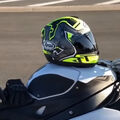The best motorcycle helmet won't offer top protection if it doesn't fit properly. Instead, it might increase your risk of injury. So, how should a flip-up helmet fit, and how can you tell if it fits correctly? Here are fundamental tips and tests to ensure your modular helmet is both comfortable and secure.
Tips for Fitting a Modular Motorcycle Helmet
An ill-fitting helmet is practically useless. Every scooter rider needs a modular helmet that fits comfortably. But how do you determine if your helmet fits correctly?
Helmet Gurus cares about your safety. A properly fitting helmet should pass the following tests:
No Space Between Forehead and Liner
Wear the helmet and try to insert a finger between the inner lining and your forehead or temple. If it's the right fit, there should be no space for your finger. If your finger can push through, the helmet is too loose.
Light Pressure on the Cheeks
After wearing the helmet, check the cheek pads. They should press lightly against your cheeks. If they don't touch your cheeks, the helmet is too large and won't protect you adequately in a fall.
Face Shield Clearance
When you pull down the face shield, it should not touch your nose. If it does, the helmet is not a good fit for you.
Read more : Saving Your Money with the Best Modular Motorcycle Helmet
Stability on Your Head
Put on the helmet, pull down the face shield, and adjust the chin bar. Move your head side to side and up and down. A properly fitting helmet should stay in place. If it wobbles or changes position, it's too big.
Even Pressure Distribution
A well-fitting helmet should feel snug and comfortable all over your head. The lining should exert even pressure without causing discomfort at any single point.
Slightly Difficult to Put On and Take Off
A firm, comfortable helmet should stay secure even with slight movement. It should be somewhat challenging to put on or take off with the chin bar locked in place. A loose helmet is likely to come off during an impact.
Comfort with Communication Devices
Many modular helmets include Bluetooth speakers or intercoms. These devices should not cause excessive pressure or discomfort.
10-Minute Test
Wear the helmet you think fits well, adjust the straps and chin bar, and keep it on for at least 10 minutes. You should be able to tolerate it comfortably during this period.
Additional Considerations for Helmet Fit and Comfort
Certification Marks: Look for at least a DOT certification. Other certifications include SNELL and ECE.
Ventilation: A well-ventilated helmet prevents discomfort from heat and sweat.
Ease of Operation: Choose a helmet you can operate while wearing gloves.
Steps to Find the Right Modular Helmet
Measure Your Head: Accurately measure your head size. Get help from a friend if needed.
Know Your Head Shape: Choose a helmet that matches your head shape.
Use Measurements as a Guide: Use your measurements to select a helmet.
Try Different Brands: Experiment with different brands to find the best fit.
Conclusion
The fit of a modular motorcycle helmet is crucial. Start by knowing your head's shape and size, then use these measurements to find a helmet that fits snugly. Ensure the helmet leaves no space between the lining and your temple, doesn't wobble, is slightly challenging to wear and remove, presses lightly on your cheeks, and distributes pressure evenly. Remember to check for certification marks. At Helmet Gurus, you'll find a variety of comfortable and reliable helmets that match your needs.
